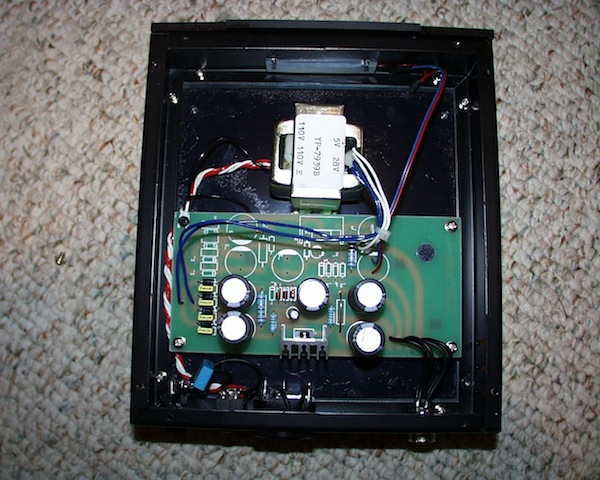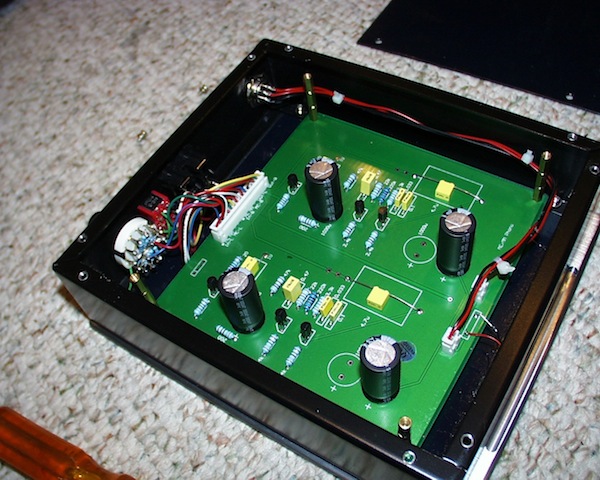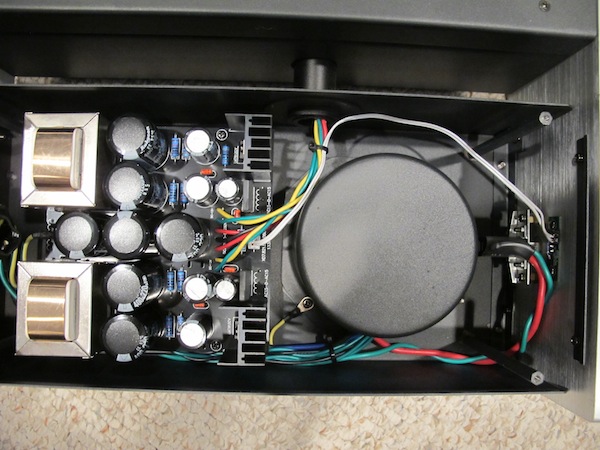Hmm seems that this article is cut off abrubtly, ending with "...also made in China and imported by"
I'm interested to hear your thoughts on the Jasmine as it gets pretty rave reviews on various forums.
I preferred the then circa $699 Graham Slee Era Gold to the Jasmine's MM input and the $699 Lehmann Black Cube to the MC input. I decided to have a look inside the two heavy backlit units.
Once the heavy top and bottom plates had been removed, the chassis appeared to be a thin grade stamped metal. The power supply transformer was small and the mirror imaged main board was missing half the parts! It appeared as if a future mod would include a dual mono power supply, but not now.

The main board was also missing a few large caps. Amplification was via two pairs of what appeared to be JFETs, which accounts for the quiet (claimed to be greater than 82dB). MC loading was via a rotary switch with a less than secure feel. When I opened the box I saw resistors not particularly well-soldered to the switch lugs.

Though it sounded okay, it struck me as providing neither $1500 in built or sound quality though it was competent and seemed an honest attempt to provide good performance for a reasonable price, but, I wrote back then, "Someone or everyone in the chain is shamelessly marking the Jasmine up way beyond usual retail mark-up and well beyond its performance capabilities."
I compared the Jasmine to Ray Samuels Audio's superbly built and outstanding sounding Emmeline XR-2 phono preamp, made in America for $1050 and the Jasmine looked, well, cheaply made and it cost more?
Cut to 2012. I was going to tell you this story to contrast the Jasmine with the Audreal but not before seeing if the product still exists and for what it's being sold and guess what? The Jasmine LP 2.0 still exists, upgraded to the LP 2.0MKII, and based on the website photo of the main board and an online review photo of the power supply, it's a much better built product, using more and better board components.
What's changed is the price: before it was replaced with the new $750 MKII version, the $1500 LP 2.0 I reviewed was selling for $639!
Someone was shamelessly marking up the Jasmine back in 2005. I have no idea how the latest Jasmine sounds, but I'll try to get one to review.
I bring all of that to your attention to introduce the Audreal LP-2, also made in China and imported by Tailored Technology. From the outside at least, build quality appeared superb.
The front and rear chassis plates are of thick, milled aluminum. The split-chassis design consists of two heavy-duty clamshell-type metal chassis connected by a large diameter metal tube. This thing weighs close to twenty pounds. And it's not because of weighted plates sandwiching a thin metal box.
At first I thought this was a dual mono design, with each chassis containing a complete phono preamplifier, but with the input and output jacks clustered on one side of the rear panel and the IEC jack on the other, clearly the power supply was on one side and the signal path circuitry on the other.
Before taking it apart to see what's inside, I plugged it in for a listen. This was back when the Pro-Ject Carbon fitted with an Ortofon 2M Red was here for review. The Audreal sounded sensational. It was reasonably quiet, spectacularly transparent in the midrange and had the flow and grace of tubes along with a rich "tubular" harmonic structure.
Most impressive of all though was the precision of instrumental attack. Tube phono preamps are almost all "sweet" sounding (though not the Art Audio Vinyl One, which had the attack and initial transient performance of the best solid state phono preamps) in the best sense of the word, but many, particularly the inexpensive ones, can sound overly soft and almost "soggy."
Given a choice between veiled and warm or hard and brittle, which is what one has to choose from among budget priced phono preamps, whether tubed or solid state, most would choose for soft, particularly from tubes, because you also get the flow and harmonic generosity.
The Audreal's overall sonic performance sounded so "right" in the context of the inexpensive Carbon with Ortofon Red 2M, I decided to set up a V-15VxMR on a Graham Phantom Supreme that I had mounted on a $25,000 Spiral Groove SG1.1 I was reviewing for Stereophile.
I wanted to hear just how good the Audreal was in the context of a true reference analog front end. All of what I've just written is in the context of a true reference system other than the analog front end: the darTZeel NHB-18ns preamp, Musical Fidelity Titan amp and Wilson Audio Specialties' $200,000 XLF speakers also under review for Stereophile.
So how did the Audreal do with the Graham/Spiral Groove combo? Better in some ways, particularly in terms of midrange purity, transparency and generous spatiality. The Audreal produced impressive depth from familiar recordings. However, it was also clear that the Audreal's bass performance was somewhat soft, rubbery and lacking in the bass transient definition more expensive units can provide and the top end was not as airy and extended as can be had on other, more expensive phono preamps (I compared it to the MM input of the $4300 Zesto Andros PS1 Phonostage and the difference in bass definition was immediately obvious). Therefore its rhythm'n'pacing was not the snappiest and its ability to produce abundant air on top was somewhat lacking, but overall it was still very good—particularly in midband transparency and overall harmonic structure.
Because its errors were of omission, I don't think anyone sitting in my chair would imagine they were listening to a....oh, I didn't say how much that Audreal costs. Frankly, while I did all of this listening I did not know!.
I actually like that. Then I have no expectations or preconceived notions. If you go to the website of the U.S. distributor,Tailored Technology, you'll see at the very bottom of the site "Exclusive U.S.A. Audreal Distributor" but inexplicably, there's nothing on the site about the LP-2. So, to get the price and some product detail I called Tailored Technology's Eric Hudgens.
But before calling him I decided to have a look inside. After removing a set of well-camouflaged screws from atop each chassis I pried off the covers. On the left side was the neatly laid out signal path circuit board containing a pair each, 12AX7 and 12AU7 vacuum tubes. Everything about the board and the components on it, exuded quality.
On the other side was a power supply that exceeded all expectations. It included a surprisingly large toroidal power transformer, a pair of substantial chokes, numerous large filter capacitors and all of the rest of the components needed to produce a high quality power supply, not a "budget" supply.

I was hoping the LP-2's price was "under $2000." Hudgens told me it was $1295! Yes. $1295, sounding, looking and feeling, inside and out, like something that could cost considerably more.
Hudgens told me he'd helped develop the product with his Chinese partners—a group of women who were both musicains and electrical engineers. Was there anything special about the circuit? After all 12AX7/12AU7 based two stage common-cathode phono preamps with cathode followers have been around for a very long time.
There was. The "secret sauce" he told me was a patented (patent number 2006200356267) circuit features: "...a delay in the process of charging and discharging the polarity plate of a capacitor. The delay between collection and release will cause signal distortion and the previous function of the circuit becomes invalidated. One effect is that the smallest signals are lost.
"The principle of our patented technology is adopting two capacitors connected in series, acting as one capacitor. A third terminal is placed at the junction of the two capacitors. A steady DC bias voltage is added on this third terminal. This insures there is a similar electric charge always concentrated on the plates.
"When signals pass through the capacitors, the similar electric charges will only change by the desired quantity instead of neutralization between negative and positive electric charges. This effectively avoids the dynamic signal invalidation by the capacitor."
Whether or not that means anything to you is beside the point. The point is, the $1295 Audreal MM phono preamp is an uncommonly good MM phono preamp at a time when most designers are concentrating on MC designs.
The $28,000 Ypsilon VPS-100 is also a MM design using but a single military grade tube and an LCR network (L=inductance, C=capacitance, R= resistance) for the RIAA filter rather than the usual CR (capacitive-resistive) network. While it can be used as a (very expensive) MM phono preamp it's intended to be used along with Ypsilon's $2800 step-up transformers.
I realize these prices are outrageous and make heads spin, but were you to hear this point to point wired phono preamp (with wire Ypsilon draws itself from silver bars, using Ypsilon wound transformers) your head would spin!
So I decided to mate a $2800 Ypsilon step-up transformer with the $1295 Audreal LP-2 to hear what this $4100 combination would produce.
It certainly didn't compare to the Ypsilon VPS-100 (which was a relief to me, having bought one!). The Audreal LP-2/Ypsilon transformer combo lost a considerable amount of bass extension and control compared to the far more expensive combo and the top end was softer and less detailed. But this was listening to a speaker that has stupendous bass performance and extension down below 20Hz. Used in a more "down to earth" system, the Audreal's combination of harmonic richness, midrange transparency and "tubular flow" will delight many vinyl fanatics at an affordable price.
Here's what I'm thinking: mate the Audreal LP-2 with a moderately priced step-up transformer package such as a $395 one from Bob's Devices, which uses CineMag transformers (total cost? $1700) and you're good to go MM or MC.
If you're using a MM or high output MC now and are considering moving to low output MC in the future, you can enjoy the Audreal LP-2 now and add a transformer later, built upon a solid foundation of a superbly built, excellent sounding MM phono preamp. The instruction manual mentions a MC option but I know nothing about it so I assume that will be a future development.
If you prefer something leaner, faster, quieter and more extended on top, but certainly lacking the Audreal's "tubular" attractiveness, consider Music Fidelity's $1195 M1 ViNL. It does both MM and MC and with all loading adjustments push button controlled on the front panel, it's incredibly convenient.
Given the brand's relative obscurity, I hope Tailored Technology offers in-home evaluation with a money-back guaranty. Ask for it. By the way, though I have a nice stash of Telefuken gold pin "diamond" vintage 12AX7s and "Bugle Boys" too, I didn't do any "tube rolling." I feel reviews should be of gear as delivered.

Hmm seems that this article is cut off abrubtly, ending with "...also made in China and imported by"
I'm interested to hear your thoughts on the Jasmine as it gets pretty rave reviews on various forums.

I got one. I have been listening to it from time to time since I bought it last year, but in the end I always prefer my old little Creek OBH-15. The Jasmine while faster, is way too strong in the upper midrange, and bass doesn't go as deep as the OBH-15. Even with upgraded power cord and umbilical cord, in my modest sytem it simply doesn't work. I guess I just prefer the listening comfort that provides the Creek phono stage. Cheers/G

I'm a Jasmine owner who thinks it's equitable for you to have a look at the Mk. II version after publishing photos and impressions of an obsolete model. I hope you do.
They are available at less than $600 depending on shipping so that changes the value proposition further.
The Audreal sounds very promising by your description and it will be interesting to see how it is received in the market. The power supply photo was impressive. Thanks for posting your impressions.

the positive reviews are for a $639 phono preamp not a $1500 one and further I suspect they are for the upgraded one, not the one in the photos
ph.d proposal

Glad to see you don't roll tubes in equipment reviews. To me, that is equivalent to modifying the equipment. If, after you review an item with stock tubes, you want to report how it sounds with other tubes, that's fine.
What's your philosophy on using stock powercords?
Vade Forrester

Michael, it was a wonderful surprise to read your review of our phono stage on Analog Planet!
When I saw the questions about tube rolling and power cords above I realized that the LP-2 had been used with the stock power cord. I agree that a component should be evaluated as received but if it is being compared in a shootout with other devices I propose that all the cabling should be consistent. I consider the 29 cent IEC cable that is included to be a “spare tire” for emergency use only.
When it was tested against the Bugatti and Formula 1 class devices in your best system it was a miracle that the LP-2 fared so well with that power cord.
I have always used the Audreal with a high quality power cord and can testify that the improvement is not subtle. I also place the unit on tuning pucks to control bass re-generation caused by mechanical vibration. This is particularly important with a system that has prodigious bass capability.
Thank you for giving us Analog Planet and keeping the world of vinyl spinning!

Hello Mikey,
Please get one of these Jasmine LP2.0MKII's and take it for a spin
The caps need at least 50 hours to burn in before it sounds good. Folks online really like this phono and think its a super value hitting way above its price point, and thats something people need to know. we all value your ears Mikey and would like to know what you think about the Jasmine.
Thanks Ron

That gear is worth every penny. Not cheap, sure, but you get what you pay for. As a marine mechanic, I know that from experience.